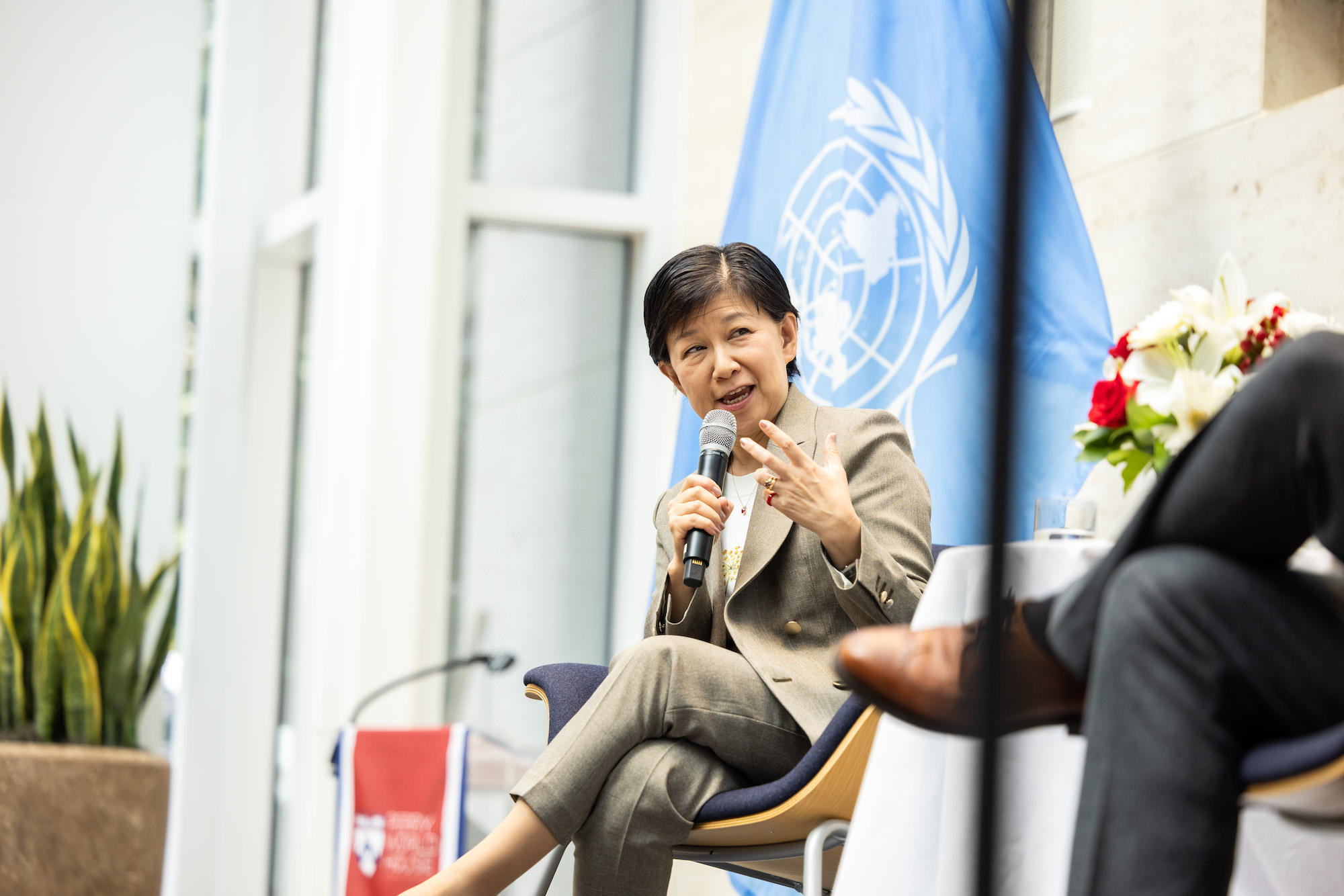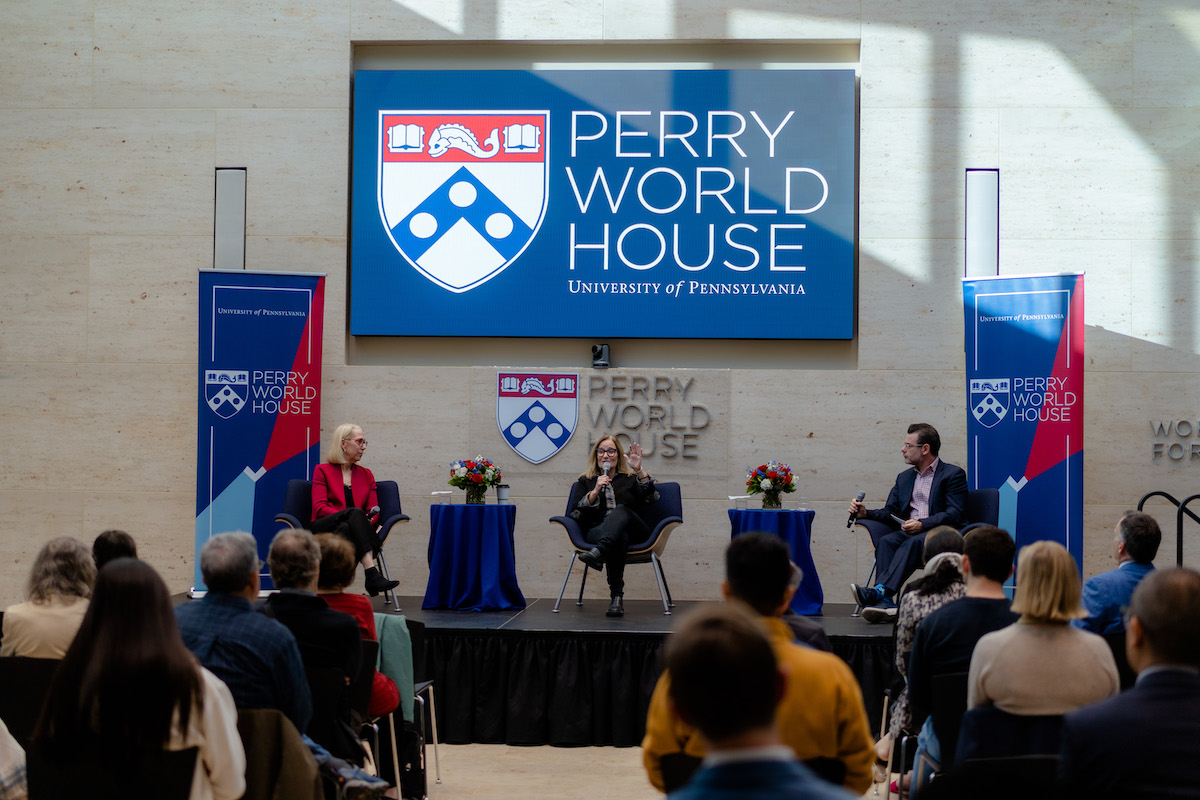
While nuclear issues have been a major part of foreign policy conversations since the first atomic bombs were dropped in 1945, the specter of nuclear threats has been on the rise in recent years. This summer’s blockbuster “Oppenheimer” brought the World War II era Manhattan Project’s ramifications to a new generation of Americans and put nuclear concerns on the front burner for many. Vladimir Putin’s nuclear threats against Ukraine, China’s modernization of its nuclear arsenal, and more pressures in the Indo-Pacific region all highlight the need for conversation around the future of nuclear weapons.
Perry World House’s 2023 Global Order Colloquium took a deep dive into the topic last week, looking at how the world will manage nuclear threats amid growing geopolitical tension, climate change challenges, and international conflict. The colloquium, “A New Age of Nuclearity? Great Powers and Greater Consequences,” featured three discussions over two days with a range of experts, starting with Izumi Nakamitsu, United Nations under-secretary-general and high representative for disarmament affairs.
Nakamitsu, in a conversation with Washington Post foreign affairs reporter Adam Taylor, discussed how her office navigates and approaches disarmament issues across the U.N. system.
Taylor started by asking where Nakamitsu’s office finds the mandate to go after its agenda on nuclear weapons, at a time when so many requests are being made of the U.N., from pandemics to the global economy.
“There is a very strong understanding and awareness that the nuclear weapons’ risk is very high,” Nakamitsu said. “We often say that it’s at the highest since the start of the Cold War.” Many member states are very concerned about that and are supporting and encouraging her office to pursue disarmament and get the entire membership of the U.N. on board, she said.
They went on to discuss the power of the Global South in framing the disarmament issue to the idea that it is a false narrative that nuclear weapons bring security to countries to whether lessons of nuclear disarmament can be applied to the field of artificial intelligence.
Taylor asked if the popularity of the movie “Oppenheimer” could be helpful in getting the general public and new generations to think about nuclear weapons and disarmament in new and useful ways.
“I do very much hope that the current, extremely risky environment would turn public opinions so that everyone has a concern. It’s not a technical question that only experts can be discussing. It’s everyone’s security,” she said, adding that, in addition to new visions, it’s important to protect the gains that have been made.
Moving to the Q & A, audience member questions addressed how to encourage responsible innovation among scientists, ways to incorporate more voices from the experts in the natural sciences, and the idea that scientists and engineers should have a sense of humanitarian law as they embark on their discoveries.
Nakamitsu said the United Nations now has an office for youth, and she encouraged the students in the audience, particularly those in STEM fields, to consider working with them to collaborate on these important security issues.
The next panel, introduced by Vijay Kumar, dean of the School of Engineering and Applied Science, explored why the nuclear danger is back, the factors that make the nuclear picture more complicated and more dangerous than in the past, and what steps governments can take to get the world to a more stable situation.
The discussion, called “Ninety Seconds to Midnight: Nuclear Dangers in the 21st Century,” was moderated by veteran journalist Bryan Bender and featured Penn alumna Rachel Bronson, president and chief executive officer at the Bulletin of Atomic Scientists, and Joan Rohlfing, president and chief operating officer of the Nuclear Threat Initiative.
The title of the chat refers to The Doomsday Clock, a measure of how close humanity is to destroying itself, and implies that humans are closer to the apocalypse than ever before. The clock is run by Bronson’s Bulletin of Atomic Scientists. She discussed current threat levels and how Russia’s invasion of Ukraine played a significant role in moving the clock to 90 seconds to midnight. The hands of the clock move forward as the threat of nuclear war grows, with midnight being the moment of global catastrophe.
“This is not your parents’ nuclear landscape. This is new, and it’s really dangerous, and we need new thinking on this, and it’s not coming from some of those sage, wise people who are retiring,” she said, urging students and young people in the audience to take up the issue of tackling the nuclear threat in whatever way the can, studies or career or free time. “The U.S. is about to spend $1.8 trillion dollars on refurbishing its nuclear arsenal. We’ve just gone through two years of COVID, sitting in our houses; is that really where we should be investing all this new money?”
Rohlfing discussed her concerns that the world is in a new chapter of the nuclear age that is more dangerous than even the height of the Cold War and the Cuban missile crisis, when the U.S. and the Soviet Union nearly went to nuclear war.
She noted the current system for preventing nuclear use is built on the theory of nuclear deterrence, and that has worked for almost 80 years. But the world has changed dramatically since the days when that strategy was adopted, going from a bipolar world to one with nine nuclear weapons states.
“We have much more powerful, more lethal weapons. We have a hot war happening in Europe. We have very high tensions with a second near-peer competitor that is China,” Rohlfing said. “We have the risk of nuclear terrorism and a rogue actor deploying and using a crude nuclear device that can completely disrupt what we think we've set up as a carefully calibrated stable system. And we have the disintegration of the safeguards, the arms control that wrapped around that system.
“I worry very much about intentional use in the context of Ukraine,” she said. “But I worry equally as much about a mistake, an accident, a technology failure, a misperception by a leader or combination of leaders that leads to nuclear use. The world needs to think seriously about how to best manage the moment and survive this current period of crisis and get to a better place, as well as tackle the longer term need to invent a better strategy “that cannot fail catastrophically the way our current strategy can.”
Rohlfing mentioned three numbers to highlight the lack of investment in nuclear issues: $9 billion, $3 billion, and $50 million. The $9 billion is an estimate of the amount of philanthropy being invested in climate change and climate solutions; more than $3 billion is the amount of money Nike spends on average for its global advertising budget; and $50 million is a best approximation of the amount of funding across the entire civil society community for nuclear work, including universities, she said.
“It’s really small compared to the nature of the challenge,” Rohlfing said.
The world needs to prioritize this issue at the leadership level, including within governments and help raise the visibility and awareness with the public and to generate funding from new funders, she said.
“We’ve seen a 50% decline over the last 10 years from the major funders within the nuclear space. It’s so ironic and sad,” she said, “that, as the threat is growing, our capacity to manage it has been shrinking.”
The final discussion looked at the goals of the Treaty on the Prohibition of Nuclear Weapons and how realistic it is to eradicate nuclear weapons from our world.
Elayne Whyte Gómez, the first president of the Treaty on the Prohibition of Nuclear Weapons’ negotiations and Costa Rica’s former ambassador to the United Nations Geneva Headquarters, was introduced by Antonia M. Villarruel, dean of Penn’s School of Nursing.
Whyte Gómez discussed the past, present, and future of the treaty in a conversation with New York Times reporter Clay Risen.
Whyte Gómez explained that the phrase “deterrence works until it doesn’t” does not capture the many different scenarios that could potentially go wrong in the nuclear landscape.
She discussed the need to strengthen the idea of delegitimizing nuclear weapons and said it’s crucial that the notion of real nuclear risks becomes a bigger concern to the general public.
Survivors of nuclear attacks and testing have been a source of strength for her and keep her motivated in the treaty negotiation process, she said.
Recordings of the colloquium’s conversations can be viewed on Perry World House’s YouTube channel.








